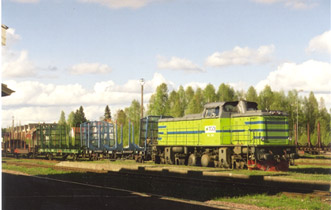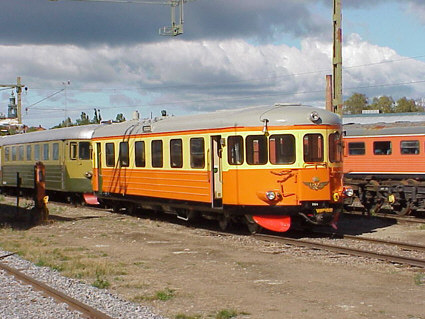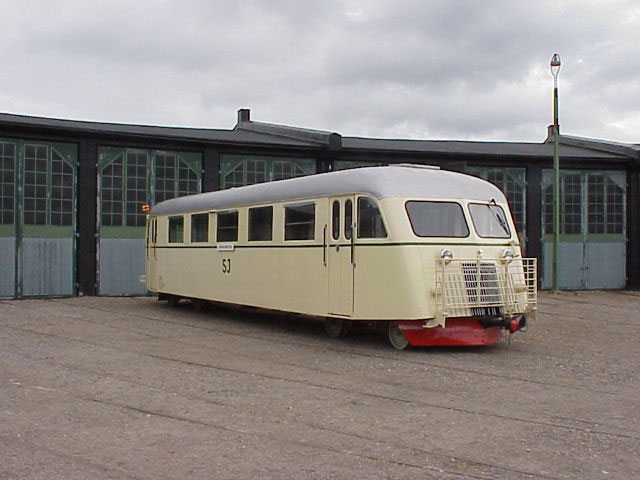
A TGOJ T43 resting for the weekend in Orsa, August 2001. See more in Ollies trainstuff!, all colorphotos by Ollie Ahokas

A Y6 motorcar at the railmuseum un Gävle in 2002.
The Y6 generation
Short background
In Sweden a need of cheaper way to offer better service than by steam powered trains was a concern for a number of operators of the large numbered of secondary mainlines and a large number of branch lines in the country. The problem was even fired by the improved highways and the technical development of vehicles roaming on these. IN 1930.es the national railroad, ordered after a couple of successful conversions of private cars to be used for track inspections a small railcar for the ore line for excursions and for locals. The railcars were constructed by Hilding Carlsson, which played a major role in the development of the railcars to the fifties. The development was fast and in late thirties a two axle enlarged car became a standard and given the Y-class. A number of these were constructed for various private lines and even in narrow gauge. Also a tiny 2-axled trailer was offered for hauling baggage. The next step was enlarging the design to ride on trucks and make it more flexible a number of trailers with different configurations gave the larger car more flexibility. These railcars were given the classes Yo/Yo1.
The 4 axle railcars of Yo 1-class in railway museum in Gävle. This is one of the pre WW II models made by Hilding Carlsson.
After the nationalisation of the privately operated line the SJ received a motley variations of different railcars ranging from converted buses to specially designs. These various cars were classified as Yo2 and Yo3.s. One of the designs was made by ex. HNJ, which offered a fast single car service between its major terminals the cars were of both types, lacked coupler and if more cars were needed, another car and a crew was sent only a few minutes after the first car. During the early post-war years Hilding Carlsson sold a number of its railcars based on the designs from the thirties.
But a need of versatile steel bodied car was urgent. After a small series of various railcars mostly for narrow gauge, and the last standard railcar for the narrow gauge Yp it was pinned that the design needed to be enlarge a bit more. And in the 1951 SJ ordered first cars of the new generation. The YCo6-class was reclassified in 1956 as YBoa6 and in 1968 as Y6.
Steelbodied Railcars of Y6 generation
Maybe the most dominant class of railroad equipment in Sweden on secondary lines are the various railcars of maybe the most dominant class of railroad equipment in Sweden on secondary lines are the various railcars of the Y6 to Y8-class railcars. When the railcars showed up they were much different from what was delivered before, with new striking paint scheme in orange and yellow. But there was a lot of teething problems, much because the long design stage of the cars, delays by alternations. By making a large order without any prototypes what so ever their problems caused many of the almost new cars were taken out of the service, waiting for solutions and rebuilding. In the beginning there were not enough trailers and a number of the sidelined cars was used, as trailers only or an older type of trailers were used temporary. But within few years the design was corrected and many not of yet delivered cars were modified. The original design was seated in 2+3, which was OK for shorter runs but SJ wanted to use it even longer runs where more comfortable interior desired. The cars used for these were classified as a YB07 later Y7 and a number of cars was needed for long runs were even more comfortable seating was offered, these was given the class YBo8-class later Y8. The cars came along with large number of various trailers as a full baggage, various combines (even with first-class seating and kitchens, full baggage and combination of postcar-baggages and full post cars. Some of the combines and full passenger trailers received even driver cabs. One railcar was allowed to pull one trailer, if the consist needed more cars, additional powered motorcars could be placed anywhere in the consist. But during the fifties and the seventies much of the branch line services were closed down and surplus of the railcars were sold of to private lines in Denmark and 4 were sold to Norway to be used on Flekkefjordline or scrapped. Mainly the cars of Y6-classes, replaced by the more comfortable Y7.s and Y8.s But during the seventies the cars were in state of needing replacement pending of decision of the future of the remaining branch lines. The cars were still used during the early eighties in Scania in southern Sweden and on the passenger services on the Inland line. But when the new railcars of Y1/YF classes were in service the remaining were rebuilt to centenary service cars or various other MoW-duty. A small number were also sold of to various rail preserving groups or rail museums in the country. When the railcars showed up they were much different from what was delivered before, with new striking paint scheme in orange and yellow. But there was a lot of teething problems, much because the long design stage of the cars, delays by alternations. By making a large order without any prototypes what so ever their problems caused many of the almost new cars were taken out of the service, waiting for solutions and rebuilding. In the beginning there were not enough trailers and a number of the sidelined cars was used, as trailers only or an older type of trailers were used temporary. But within few years the design was corrected and many not of yet delivered cars were modified. The original design was seated in 2+3, which was OK for shorter runs but SJ wanted to use it even longer runs where more comfortable interior desired. The cars used for these were classified as a YB07 later Y7 and a number of cars was needed for long runs were even more comfortable seating was offered, these was given the class YBo8-class later Y8. The cars came along with large number of various trailers as a full baggage, various combines (even with first-class seating and kitchens, full baggage and combination of postcar-baggages and full post cars. Some of the combines and full passenger trailers received even driver cabs.One railcar was allowed to pull one trailer, if the consist needed more cars, additional powered motorcars could be placed anywhere in the consist. But during the fifties and the seventies much of the branch line services were closed down and surplus of the railcars were sold of to private lines in Denmark and 4 were sold to Norway to be used on Flekkefjordline or scrapped. Mainly the cars of Y6-classes, replaced by the more comfortable Y7.s and Y8.s But during the seventies the cars were in state of needing replacement pending of decision of the future of the remaining branch lines. The cars were still used during the early eighties in Scania in southern Sweden and on the passenger services on the Inland line. But when the new railcars of Y1/YF classes were in service the remaining were rebuilt to centenary service cars or various other MoW-duty. A small number were also sold of to various rail preserving groups or rail museums in the country.